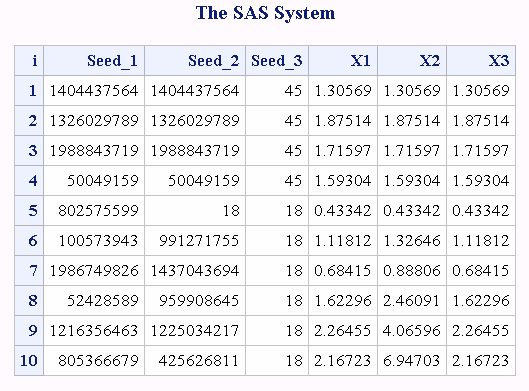CALL RANGAM Routine
Returns a random variate from a gamma distribution.
| Category: | Random Number |
Syntax
Required Arguments
seed
is the seed value. A new value for seed is returned each time CALL RANGAM is executed.
| Range | seed < 231 - 1 |
| Note | If seed ≤ 0, the time of day is used to initialize the seed stream. |
| See | Seed Values and Comparison of Seed Values in Random-Number Functions and CALL Routines for more information about seed values |
a
is a numeric shape parameter.
| Range | a > 0 |
x
is a numeric variable. A new value for the random variate x is returned each time CALL RANGAM is executed.
Details
The CALL RANGAM routine
updates seed and returns a
variate x that is generated
from a gamma distribution with parameter a.
By adjusting the seeds,
you can force streams of variates to agree or disagree for some or
all of the observations in the same, or in subsequent, DATA steps.
For a>1, an acceptance-rejection method by Cheng
is used (Cheng, 1977). For a ≤ 1, an acceptance-rejection method by Fishman is used (Fishman,
1978). For more information see References.
For a discussion and
example of an effective use of the random number CALL routines, see Starting.
Stopping, and Restarting a Stream.
Example
data u1(keep=x);
seed = 104;
do i = 1 to 5;
call rangam(seed, 1, x);
output;
end;
call symputx('seed', seed);
run;
data u2(keep=x);
seed = &seed
do i = 1 to 5;
call rangam(seed, 1, x);
output;
end;
run;
data all;
set u1 u2;
z = rangam(104, 1);
run;
proc print label;
label x = 'Separate Streams' z = 'Single Stream';
run;
Copyright © SAS Institute Inc. All rights reserved.

